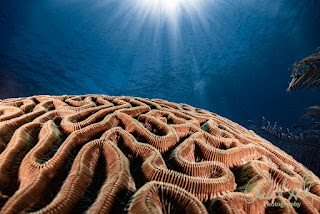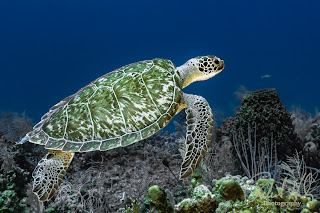Mastering White Balance in Lightroom for Underwater Photograph
How to Fix White Balance Issues Common in Underwater Photos
Have you ever looked at your photos from a dive and felt disappointed because they didn't capture the stunning colors you saw underwater? You're not alone. It's a common challenge for photographers to accurately represent the vibrant underwater world, and one of the main reasons for this is the difficulty in achieving proper white balance. The bluish or greenish tint in your underwater photos is caused by how water absorbs light at different depths. Luckily, Adobe Lightroom offers powerful tools to help you correct these white balance issues and bring out the true beauty of your underwater images.
In this post, I will walk you through the steps for adjusting the white balance in Lightroom. This process will help you enhance your photos by correcting dull, blue-tinted images and bursting them with vibrant colors. Whether you are editing stunning underwater landscapes or intricate macro shots, these techniques will elevate your images and accurately depict the beauty of the underwater world.
Why White Balance Matters in Underwater Photography
Light behaves differently underwater. As you go deeper, red, orange, and yellow are filtered out, and the images are dominated by greens and blues. Factors like water clarity, sunlight, and shooting angle compound this effect. Unfortunately, automatic white balance settings on cameras often can't compensate accurately, resulting in flat and washed-out images.
The adjustment of white balance during post-processing is crucial for enhancing photographic quality. By meticulously fine-tuning the white balance using software such as Lightroom, one can effectively restore the natural hues and vibrancy of the images, thereby presenting a more authentic depiction of the original scene.
Step-by-Step Guide to Correcting White Balance in Lightroom
Import Your Image into Lightroom's Develop Module:
- To get started, open Lightroom and import your image. Once your image is imported, navigate to the Develop module. In this section, you will have access to various tools that can help you address any white balance issues in your image.
- A helpful tip is that if you capture your images in RAW format, you will have a broader range of options for adjusting white balance. RAW files contain more color information than JPEG files, allowing for more precise and flexible color correction. By working with RAW files, you can achieve greater control over the color balance in your images.
Use the White Balance Selector Tool:
- When you need quick white balance adjustments in Lightroom, the White Balance Selector tool, represented by the eyedropper icon, is your best bet. To use this tool, click on it and select an area in your image that you believe should be a neutral gray or white. This could be something like a piece of coral, sand, or even a bubble.
- Lightroom will automatically adjust the temperature and tint sliders based on your selection. This straightforward adjustment can eliminate color casts and provide a more neutral foundation for further color correction in your image.
Fine-Tune with the Temperature and Tint Sliders:
- After using the White Balance Selector, you can manually fine-tune the Temperature and Tint sliders to adjust the color balance of your photos. When shooting underwater, the colors tend to get washed out, so you'll likely need to increase the Temperature to reintroduce the reds and yellows that may have been lost at depth. Use the Tint slider to correct any green or magenta hues in your underwater shots.
- Here's a pro tip: Judicious use of these adjustments is essential. Overwarming your photo can result in an unnatural look, while excessive tint changes can disrupt the overall color balance of your image.
Make Color-Specific Adjustments Using the HSL/Color Panel:
- In the HSL/Color panel, you can finely tune the hue, saturation, and luminance of specific colors within your image. This feature is handy for enhancing the appearance of particular elements, such as coral or fish, without impacting the entire image.
- By boosting the saturation of reds and yellows, you can make these colors more prominent and vibrant. Conversely, if the blues in your image are overpowering, you can reduce their saturation to achieve a more balanced look. More prominent and vibrant. Conversely, if the blues in your image are overpowering, you can reduce their saturation to achieve a more balanced look.
Enhance with the Color Grading Panel:
- To make more intricate color adjustments, navigate to the Color Grading panel. Within this panel, you can individually manipulate the colors in your image's shadows, mid-tones, and highlights.
- Leverage this functionality to delicately infuse warmth into your highlights or introduce a cooler tone to your shadows, creating a harmonious balance in your image's overall visual presentation.
Use Local Adjustments for Targeted Edits:
- In some cases, more than making global photo adjustments may be required. In such situations, you can utilize Lightroom's local adjustment tools, such as the Brush, Gradient, or Radial filters, to apply specific edits to targeted areas of the image.
- For instance, if you have a photo of a brightly colored fish that appears muted, you can use a radial filter to selectively enhance the saturation and warmth only in the area where the fish is located.
Example Applications of White Balance Correction
1. Wide-angle reef shots: You may notice a dominant blue or green cast in your photos. To correct this, you can use the White Balance Selector tool to pick a neutral gray area on the reef. After that, you can increase the Temperature to bring back the warm colors of the coral and fish and adjust the tint to balance out any green hues. Additionally, you can use the HSL/Color panel to enhance the coral's red, yellow, and orange tones, adding vibrancy and bringing the reef to life in your photos.
2. When taking macro shots: Consider that the loss of reds is less severe due to the shorter shooting distance. However, the subject might still appear cool-toned. To address this, adjust the temperature slider to warm the image overall. Additionally, use a radial filter to selectively enhance the reds and yellows of your subject. This technique will make the macro subject stand out without affecting the surrounding watercolor, allowing for a more striking and vibrant image.
3. Wreck Shots with Artificial Light: Combining warm and cool tones in the image with artificial light, such as strobes, is common. To address this, start using the White Balance Selector on a neutral gray area of the wreck. Then, you can further adjust the white balance using the Temperature and Tint sliders. Additionally, you can enhance the highlights by adding warmth to the Color Grading panel and create a balanced, dramatic effect by selectively cooling the shadows.
Final Tips for Mastering White Balance
- Use a Reference Photo: When capturing underwater photos, it's essential to use a reference photo to help with white balance adjustments during post-processing. You can achieve this by photographing a gray card or slate underwater. This reference photo will significantly simplify correcting the white balance in your images.
- Create a Lightroom Preset: After editing an image to your satisfaction, consider saving the adjustments as a Lightroom preset. This will allow you to apply the same settings to future photos, particularly those in similar underwater conditions, streamlining your editing process.
- Experiment, but Don't Overdo It: While editing, it's essential to experiment with different adjustments, but be cautious. It's easy to go overboard with color corrections, so it's crucial to regularly compare your edits with the actual underwater colors to ensure that they appear natural and realistic.
Bringing It All Together
Achieving mastery of white balance in Lightroom is crucial for elevating the quality of your underwater photography. When equipped with the appropriate tools and techniques, you can salvage overexposed images and unveil the genuine allure of your underwater subjects. Remembering that the objective is to enhance the natural beauty you witnessed rather than embellishing it is essential. By adhering to these suggestions and harnessing the robust capabilities of Lightroom, you can effectively metamorphose your photos from lackluster and subdued to vivid and true-to-life.
Need more help? Feel free to contact me (bob@robertherb.com) or comment below if you have questions or want to see a step-by-step video tutorial for any of these techniques. Happy editing, Oceanic Adventurer, and may your underwater colors shine as brightly as the reefs!
Stay Connected
Follow my blog for more tips and tutorials on underwater photography. Let's dive deeper into the art and craft of capturing the marine world!
Subscribe to my blog for more tips and tutorials on underwater photography. Don't forget to share your processed photos on social media using the hashtag #RobertHerbPhotography. I look forward to reviewing your results.
New Online Training Program
I am excited to announce that I am creating an online training program to teach underwater hobbyists and enthusiasts how to enhance their photos using Adobe Lightroom. If you are interested in this training or need more information, please go to (Underwater Photo Training) or contact me at bob@robertherb.com to express your interest and to be notified about the details and start date of the classes.
Stay tuned and "Follow" for upcoming blogs on underwater photography tips and tricks for more in-depth insights. Please leave your comments and suggestions. Enjoy your diving and shooting experience!
I am eagerly anticipating your valuable feedback and suggestions.
Sincerely,
Bob Herb
|
|






Comments
Post a Comment
Please let me know your comments.